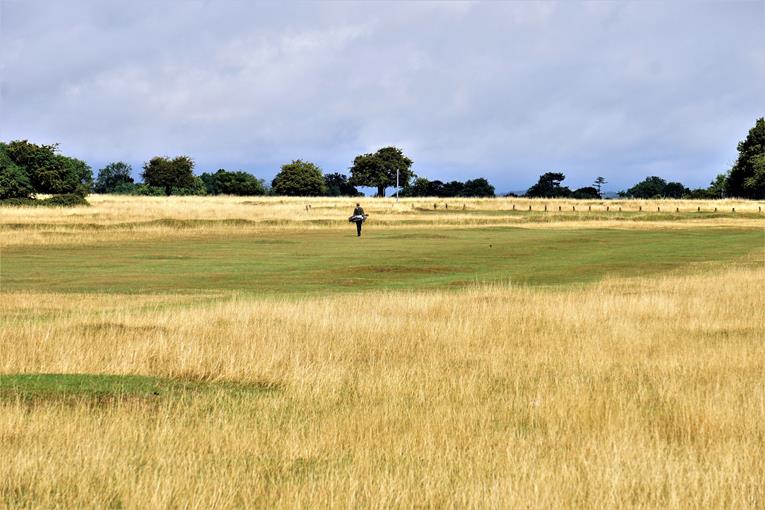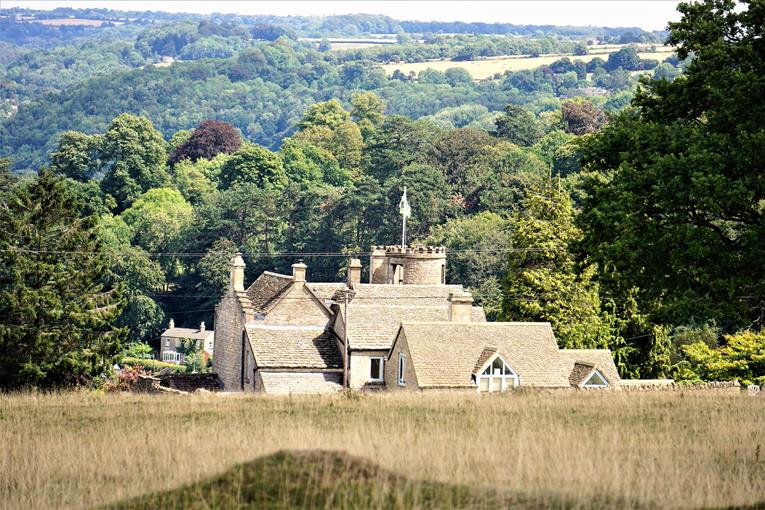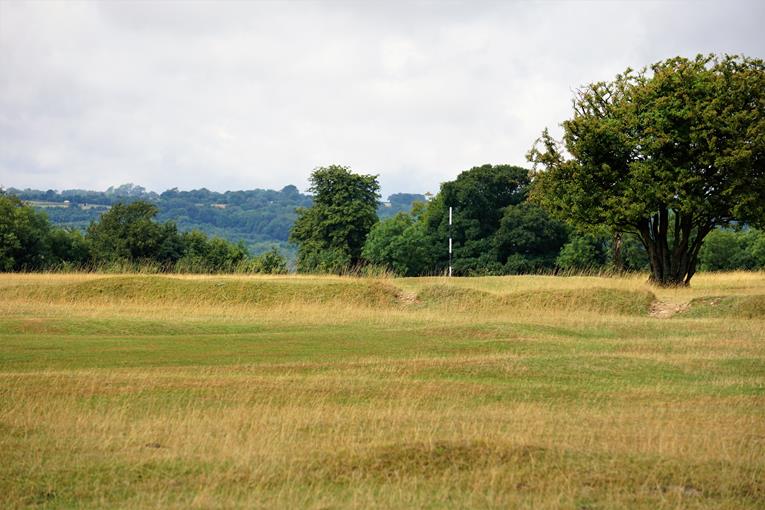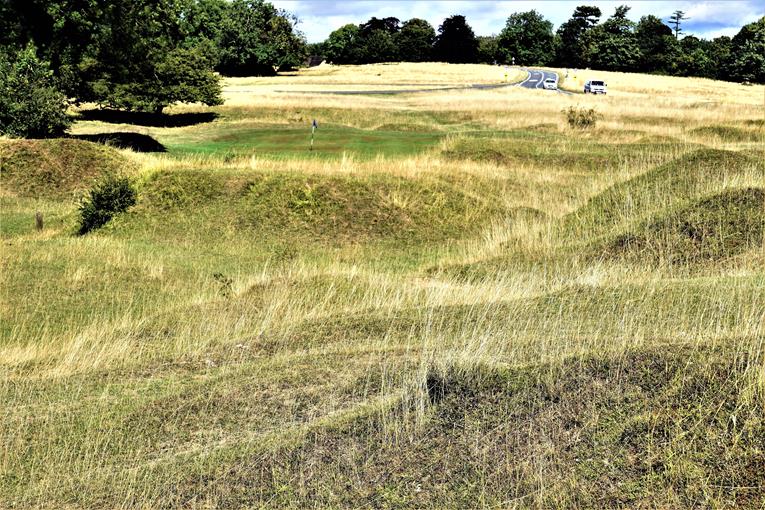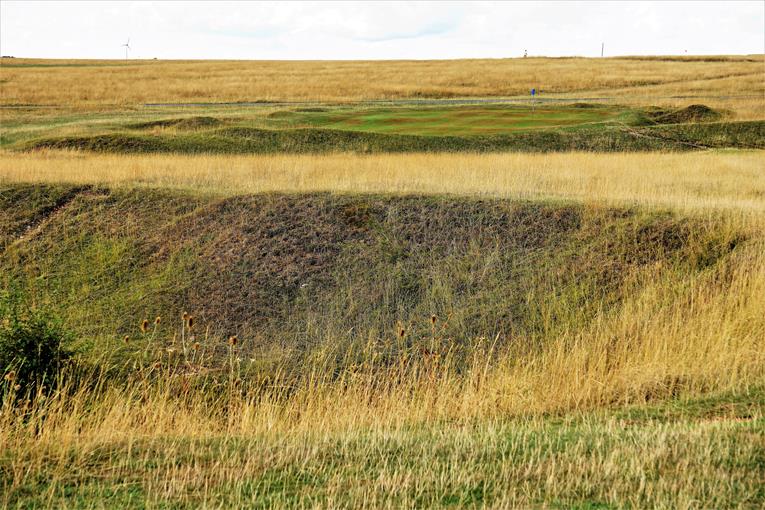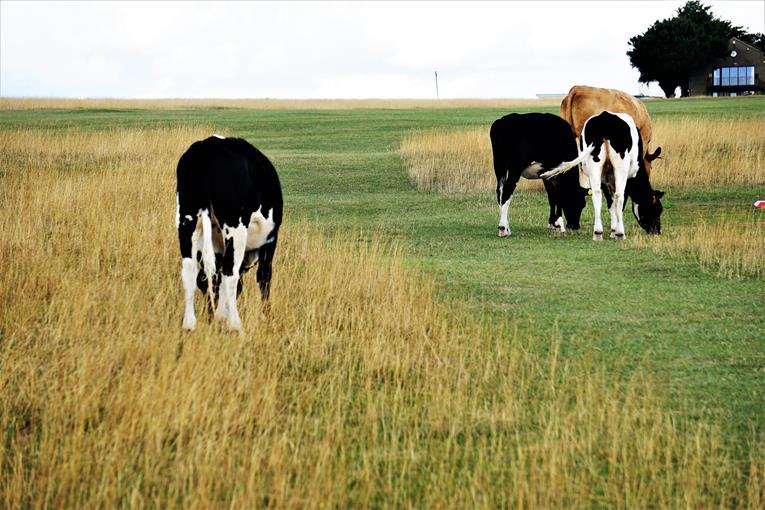Minchinhampton Golf Club – Old Course
United Kingdom
Some clubs take delight in sequestering themselves from the masses. With few exceptions, the author finds such efforts ring hollow. If a golf course doesn’t feel a part of its greater surrounds, then a sense of artificiality (or even worse, preciousness) likely will prevail. In terms of pure playing experiences, common ground courses rank highly with the author. By definition, they are a part of their surrounds and they lack specious features, two stepping stones toward greatness.
After posting the Royal North Devon course profile, the king of common ground courses, in September 2017, I received an email from Thomas Dai, extolling the virtues of another common ground course a couple of hours north and east in Gloucestershire. I was keenly aware of it from Sean Arble’s profile (found here) and Thomas’s endorsement was unwavering. While acknowledging the merits of other nearby common courses like the hilly Cleeve Cloud with its splendid views, Thomas thought Minchinhampton Old possessed a graceful charm and quiet dignity unto itself. Arrangements were made to join Thomas and Sean there in August 2018 and this profile is the result. Though we were there for two days, the weather/lighting only cooperated sporadically (i.e. typical British weather!). Afternoon and morning storms thwarted efforts to gain a full complement of photographs and more will be added from future pilgrimages.
The Minchinhampton Common sits high with the villages of Amberley and Minchinhampton below. Horace Hutchinson, a man of many accomplishments including being the first to eloquently write on golf architecture, beautifully summed up its setting in 1897 in British Golf Links: ‘The links are situated on a spur of the Cotswolds, about seven hundred feet above the level of the sea, commanding views of the main range of the Cotswolds in one direction, and on the other side looking over the beautiful vale of Berkeley, and the Welsh hills in the extreme distance. The turf is always fine, short, and springy, affording good “lies”; and the main “hazards,” consisting of deep and wide quarries, are decidedly formidable.’
As you enter the clubhouse, the first hole is perpendicular and slides downhill to the right with the Home hole coming up the same hill on the other side. If you designate the first and eighteenth holes as approximating noon on a clock , the rest of the holes travel clockwise in something that ressembles a circle. True, the third green comes back within 200 yards of the clubhouse but otherwise, the holes stay over 500 yards from the clubhouse until the final march up the Home hole. The ninth tee is the farthest point from the clubhouse and there is gobs of non-golf space surrounding most holes. No man-made contrivances like bunkers or buildings are allowed on the 450 acre common, and the overall effect is one of vast spaciousness.
Wind plays a vital role and indeed, early descriptions of the course dub it a links, including Hutchinson’s. Perimeter holes like the second and twelfth afford smashing views across the countryside. Other than the opening and closing holes, no two are parallel and a sense is provided that you are always moving forward and exploring a different portion of the property. It is an exemplary routing and unlike any I can recall.
Hutchinson writes that the Club was ‘… established in 1889 by a few local gentlemen, amongst them the present treasurer Mr. Clement Ritchie, an old Blackheath resident, who appreciated the capabilities of Minchinhampton Common for making good inland golf links. With the assistance of Mr. A.T. Playne …’ Hutchinson then highlights how important it was that the Club immediately ‘… engaged the services of R. B. Wilson, of St. Andrews, as professional, who practically laid out the present links, which has since only had some slight alterations.’ Again, those are words from British Golf Links in 1897 and apart from his shout-out to those three gentlemen, little future credit is specifically bestowed to individuals for the intelligent manner in which the course has changed over the years. Two things are certain: the course evolved extensively from its Victorian roots and it did so without the formal involvement of a titan like Harry Colt or Herbert Fowler.
Indeed, there have been five primary iterations to the course according to member Mr. N.E. ‘Tank’ Nash CBE who penned a wonderfully colorful account of the club’s history entitled Where Tom Long Roamed – The History of Minchinhampton Golf Club and its Three Courses 1889-2014. The book is still available for sale in the professional shop and my use of the word ‘colorful’ is well advised. For example, Mr. Nash ends his brief biography with this corker: ‘He plays most of his golf with the Seniors who will, on every Monday morning in the future, bend his ear on the manifold deficiencies of this book.’
As can be discerned from reading Mr. Nash’s account, Wilson’s original routing lasted upwards of 25 years but today’s course bears little resemblance with the exception that the 11th green site is still in use. The backbone of today’s gem was formed from 1915 through 1926, including the creation of the first, second, third, fourth holes, the fifth green, the famous eighth, ninth, thirteenth, and eighteenth holes. The holes weren’t numbered the same then as the opener was today’s fourth. Three crucial holes – the fifteenth, sixteenth and seventeenth – were added after World War II and today’s sequencing took hold then as well.
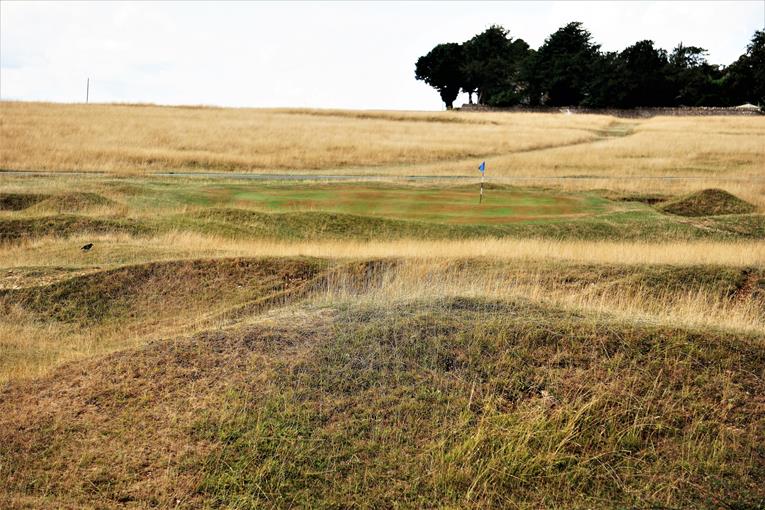
Many of the best holes at Minchinhampton, including the one shot 16th above, were added after 1915 (i.e. after Hutchinson praised the course).
A final few tweaks occurred this century, including the removal of two road crossings with one’s tee balls at the fifteenth and seventeenth. In every case, the changes were driven by the advent and the ever-increasing popularity of the motorized vehicle, otherwise known as the car. The golfer crosses a road five times during the round and a couple of the roads have become quite busy, such is the popularity and fame of the Cotswolds these days. Despite the road crossings, the course sparkles – how? Same as any other course: by having a slew of great golf holes, all of which were made special by how man laid the holes over the land. Some are special because of the placement of greens in pre-existing hollows (the first, eighth, and eleventh), others by capitalizing on the quarries and craters that dot the property (the seventh, ninth, and sixteenth) and others still be the Bulwarks (the twelfth and thirteenth) and mounds/trenches (the fourth). These features predate the formation of the course – sometimes by more than 1,000 years! Nash surmises that ‘The Common ground in Minchinhampton has been a site of human activity since, at least, the Neolithic period and long before the three putt was invented in Scotland, imported and suffered in Gloucestershire these last 125 years.’ Again, please note the fabulous prose!
Some changes like the shifting of the tees forward and to the right on the sixth and the creation of the one shot fourteenth to avoid road crossings are fine. Today’s tee ball at the sixth still plays over some frightening landforms while the one shot fourteenth is admirable in its simplicity and feels a part of the course’s overall fabric. Indeed, one version of the old fourteenth had it crossing not one but two (!) roads.
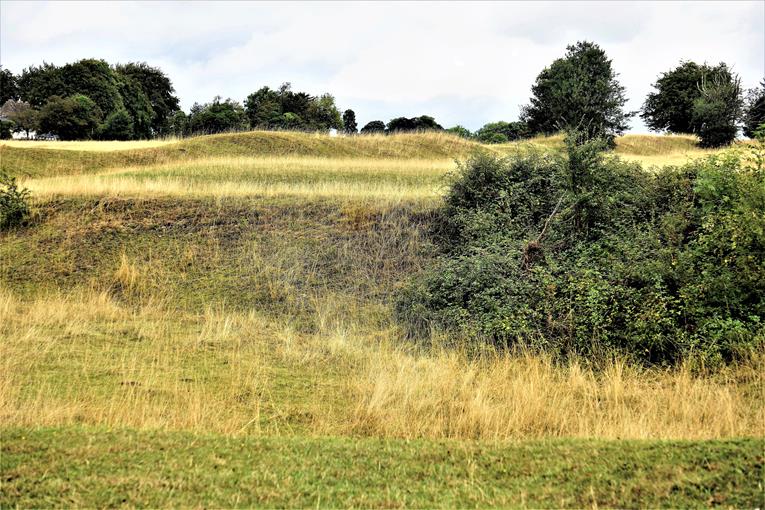
Today’s sixth tee ball has lost none of its charm, even if the hole is 40 yards shorter with the golfer no longer asked to hit over the road.
The new tenth is trickier to discuss. True, today’s green enjoys its own little pocket on the property and the old one played toward a well trafficked road. Alas, it also played over the deepest quarry from where stone was once pulled. Hutchinson shows a glorious picture of it in British Golf Links, with its green perched precariously beyond two quarries that must be over fifteen feet in depth. Consider that a niblick (a nine iron with a loft around 42 degrees) was likely the highest loft club in most bags and that this hole was built in the age of the gutta-percha! WELL – what a terror it must have been – Pete Dye would have been proud! Today, the quarry is engulfed by jungle, so Hutchinson’s book best displays the hole’s former grandeur. Hutchinson notes, ‘It is worth mentioning that every professional who has visited the links has in one of his rounds broken down at this hole.’ His own description of it – ‘a beautiful piece of turf between two roads and two quarries’ – tells you why it is no longer with us.
Perhaps an even bigger blow was how the twelfth green was moved seventy yards away from its original spot near the road. This is a pity as the second or third shot originally had to be played blind over a daunting series of mounds known as Bulwarks to a green surrounded by depressions. What a nervy par 5 that would have been in its day but no use crying over split milk: it was simply too close to a road that became too busy. Something had to be done and moving the green away from the road was the obvious, sensible solution. Nonetheless, in the process, the Bulwarks became more of an adornment to the hole than something integral that had to be hit over. The fact that today’s twelfth stands out because it plays in a relatively straightforward manner with the Bulwarks off to the right is testament to the quality of the other seventeen holes. Though regrettable, the moving of the tenth and twelfth greens was integral to keeping golf on the common, which is surely the imperative.

Hello there! Livestock are allowed to roam May through October. Manure on the green is treated as ground under repair and free relief is afforded.
Enough about history! What matters are the holes that we play today. And there are a number of standouts, as we see below. The course stretches to nearly 6,100 yards from the back markers as captured below. After the tour, see if you don’t agree with Adam Lawrence of Oxford Golf Consulting, ‘You’d have to mistrust anyone who doesn’t like those old Cotswold common courses.’
Holes to Note
First hole, Beaudesert, 480 yards; The well placed tee is in a corner formed by the clubhouse left and the lodge behind with the scene ahead being one of pure golfing bless: fescue grass sways in the breeze and frame a wide fairway with nothing man-made that jars the eye. The connection to nature and to playing golf on a grassy plateau is both immediate and real with this 1/2 par hole informing the golfer quick smart that the ground game reigns supreme. For those with enough length to reach in two, judging how far short to land one’s downhill approach to the green is an art form. Small banks and ridges close in on the hidden putting surface, sunk low in a dell. A rousing start of the highest order.

The sweeping view down the 1st confirms Minchinhampton as a minimalist’s delight. Imagine how much worse the view would be if a bunker blotted the horizon. Also, it is important to note that this fescue is of the wispy sort and finding balls is no undue chore.
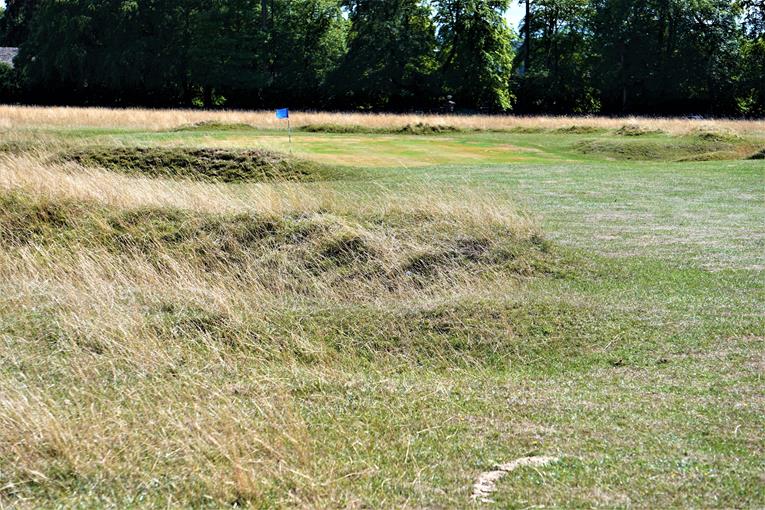
Approach shots from well back must land before the green and will then trundle down the ramp and onto the open, sunken 1st green.
Second hole, Pinfatherings, 480 yards; The second bends right around the same gentle slope that the first went down. As the fairway slopes right to left and the hole swings right, shades of The Olympic Club and its famous reverse camber holes come to mind. The pushed up, shallow green is especially vexing to hit from well back, as it is much broader (31 yards) than it is deep (17 yards). Though the course measures 6,100 yards, already you have used long irons and hybrids. As you leave the green, you walk some sixty yards down and to the left to the third tee. Why so long, you wonder? Because the second green was once much lower and closer to the escarpment but had to be moved for public safety reasons. It is an example of a hole that has changed but not for the worse and perhaps even for the better.
Fourth hole, The Reservoir, 340 yards; Mr. Alan Dangerfield, the Club Administrator, notes that the mounds on the fourth existed centuries before golf was invented and ‘ … were not man-made for course design. As most of the common was a wooded area during Roman & Saxon times, it is thought that these trenches relate to the management of these early medieval woods, perhaps internal boundaries dividing wood-pasture from ungrazed woodland.’ Where it gets exciting for golfers is in how these mounds and trenches were incorporated into the hole. This particular series of mounds extend in a semi-circular manner for over 500 yards on both sides of the reservoir. Someone on the committee had the foresight after 1915 to route this hole in a manner so that the mounds diagonally cross the fairway some fifty yards before the green before tracking along the right and into another paddock. The stewards of the course deserve applause for possessing the innate knowledge that diagonal features are compelling design attributes.
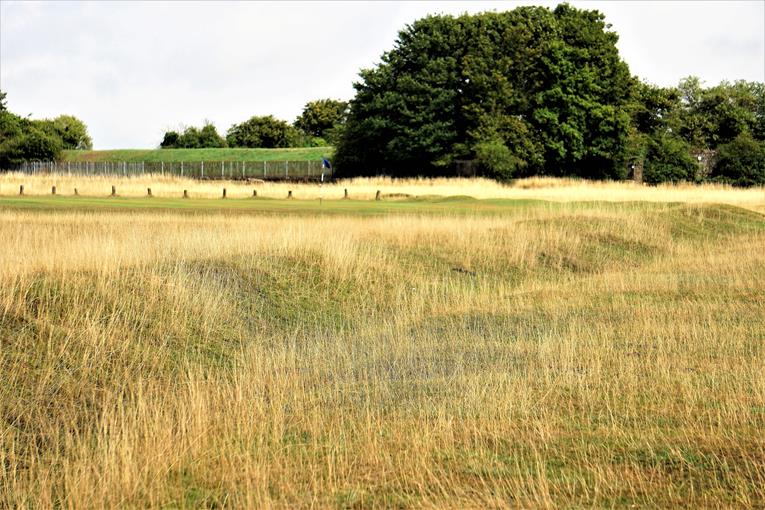
A trench and the resultant mounding angle from left to right across the 4th fairway. A failed reservoir is the distant, handsome backdrop.
Fifth hole, Amberley, 410 yards; A quick check of the first five holes shows the first peels downhill, the second with its attractive sidehill architecture, the third playing straight uphill, the fourth across a plateau, and now the fifth, which features a blind drive over the crest of a hill to a green set further below. The point is simple: some confuse a common as a level plateau, which is inaccurate. Similar to the first, gauging the downhill approach properly is a satisfying moment and it highlights two of the course’s indefatigable attributes: the golfer must learn to use the ground and position matters off the tee. Approaching this green pad, a mere 21 yards in depth, at an oblique angle does not routinely work in the golfer’s favor.
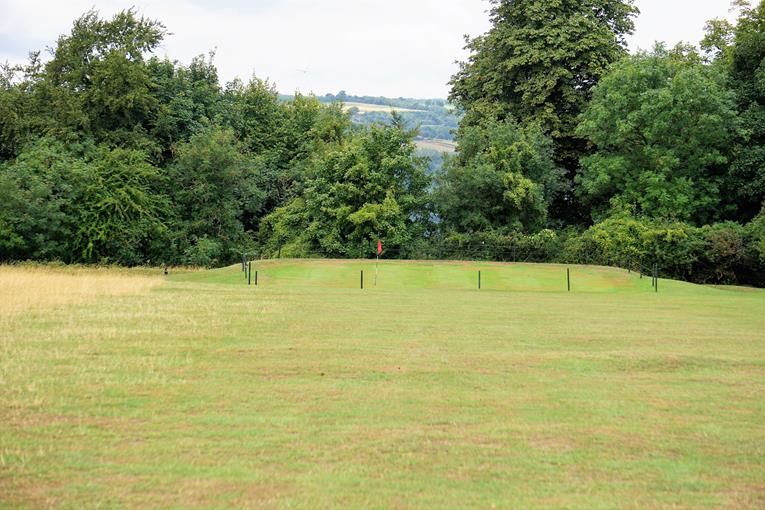
The only regret that the author has regarding the course presentation is how this view has been diminished by tree growth. Just imagine the stunning backdrop when the 5th was created some hundred years ago!
Seventh hole, Whitefield’s Tump, 365 yards; Though the configuration after World War II was a dogleg right, today’s hole plays fine as a slight dogleg left! Each version veered around the same crater with today’s hole featuring the crater short and left of the green. No surprise to learn that the prior version was altered because the green was a bit snug to a road.

The view from the 7th tee is of land that has been spared the touch of man for golf. It is the fourth drive out of six where the golfer is unlikely to see where his tee ball finishes.
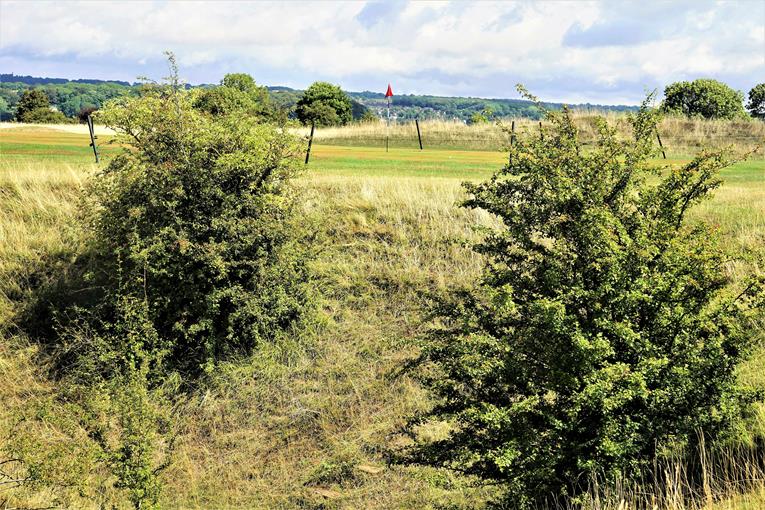
As seen short left of the 7th green, this crater represents no man’s land. People might sniff at a course with no bunkers as they can only imagine it to be featureless but as we have already seen, Minchinhampton is anything but!
Eighth hole, The Bear, 180 yards; Ironically, some holes take on exalted status despite the fact that they are a break from the course’s norm. Take Amen Corner at Augusta National – one of the reasons those three holes are celebrated is the manner in which they introduce water into the mix. Other than a snap hook drive at the second at Augusta, the golfer has yet to confront such a hazard and so when he does, the nerves tend to unravel at a disturbingly quick pace! Some of that sentiment applies here: Old Minch is truly a course that celebrates the ground like few others yet two of its most acclaimed holes (here and sixteen) make an aerial approach compulsory. Yet, both still constitute ‘great’ – the golfer is given a task that should he complete it, he swells with pride but should he fail, he still looks forward to the next time. Yes, it’s a forced carry from the white tee but in fairness, the golfer is granted a perfect lie on the tee. The carry is within reason and the broken ground holds the identical appeal of ruff hewn links land that feels untouched for millennia. Elemental golf at its best – with some excellent green contours to boot to keep the tiger on his toes.
continued >>>
Minchinhampton Golf Club – Old Course
United Kingdom
Ninth hole, Dew Pond, 375 yards; Two key features expertly rub off each other: a pit left off the tee and a sharply canted green from right to left. As the golfer plays away from the pit, his angle of approach worsens in what amounts to perfect architecture. Sean Arble, who has done more in the past decade to extol the virtues of golf in the English countryside than anyone, describes the ninth thusly: ‘Tom Simpson, the English architect as well known for his arrogance and aberrant behaviour as for elegant architecture, once quipped “The vital thing about a hole is that it must either be more difficult than it looks, or look more difficult than it is. It must never be what it looks.” At the heart of Minch Old’s middle of the round purple patch is the splendid 9th, a hole which certainly isn’t what it appears to be and without question is more difficult than it looks. Unlike much of what comes before and after, from the tee the obvious appearance of this two-shotter looks like a hole out of Minchinhampton place and time. Simplicity itself, the 9th bows left around a quarry and is of a distance which causes little concern. The charms of the hole aren’t fully revealed until after a clever, safe play right … well away from the quarry. The golfer turns the corner and soon fathoms that the combination of a diminutive green tilted away from play and expertly placed humps and hollows has left him in an untenable position. Will the golfer accept the situation and play accordingly or will the decision be a bold one which risks finding a second quarry left of the green?’
Eleventh hole, Tom Longs, 430 yards; More of this hole pre-1900 remains in play than another hole. Standing on the tee, the golfer looks well into the distance and is unclear what he sees. It almost looks like the dark flag is lying on the ground and that someone perhaps forgot to put the flagstick back. Upon closer inspection, the golfer determines all is well, it is just that the green is located in a four foot deep hollow with the flag barely visible. The sensation of hitting toward this green complex is invigorating, in part because so many options exist all of which have appeal. Do you hit a low rolling bullet draw, and have the ball tumble out the last 40 yards until it disappears into the bathtub? Do you play more of a conventional shot and have the approach land just short before descending into the hollow? Or last, do you hit a conventional shot that flies all the way and let the ball wander off the sides or back wall? Regardless of whether you go high or low, the walk toward the green is done in mystery as to the outcome. If the ball is close, you potter around and hope that a passing car might notice what a superb golfer you are!! The competition for ‘best shot on the course’ is fierce but the approach to the eleventh is one of the candidates – and has been one of England’s standout holes for over 125 years.

One of the great remnants from Victorian golf is this green complex. The traffic pattern is a bit muddled due to the livestock crossing.
Thirteenth hole, The Holly Bush, 365 yards; The mirror image to the fourth with one important exception: the string of mounds that separate the tee and green are taller than a person here and so the green is out of sight for one’s approach. No wonder this course was referred to as a links. Mr. Dangerfield explains the size of these mounds, known as Bulwarks, ‘They date back to the iron age and are thought to surround the village of Minchinhampton enclosing an area of about 200 acres. Because of the bank outside the ditch it is believed that the Bulwarks were intended to keep things in rather than out and the obvious interpretation is that they represent a giant animal corral.’ You be the judge as to which architecture is more meritorious: Minchinhampton’s, with its varied features that are directly in the line of play and that must be crossed versus that of modern architecture with superfluous bunkering that is expensive to maintain and that is frequently and pointlessly placed on the sides of holes!
Fifteenth hole, Box View, 430 yards; This hole reintroduces an attribute found early in the round, namely you won’t see where your tee ball finishes. You have since the ninth but not here as you play over a hill crest. The kicker is how the green follows the land and it too slopes from front left to back right and away from the player. Again, this hole encapsulates lay-of-the-land architecture, especially how the green wasn’t propped up to receive a shot like ‘a catcher’s mitt’, as Max Behr once shrewdly complained. The diverse, exhilarating four hole finish cements the course as a personal favorite and ultimately helped the course join the 147 Custodians of the Game on GolfClubAtlas.
Sixteenth hole, Centenary Hole, 165 yards; Similar to the eighth, the golfer tips his hat in appreciation as to how a one shotter can be so visually compelling without any bunkers. The pitched, cascading green is surely the most vicious on the course and the author always appreciates features in the late stage of a round that prey on nerves as this green clearly does. In the dry summer of 2018, to be above this hole was to court additional strokes as the grass on the green provided insufficient friction to make a downhill putt stop anywhere near the desired area. Great golf made even better by the presentation, with the course beautifully reflecting the area’s parched conditions.
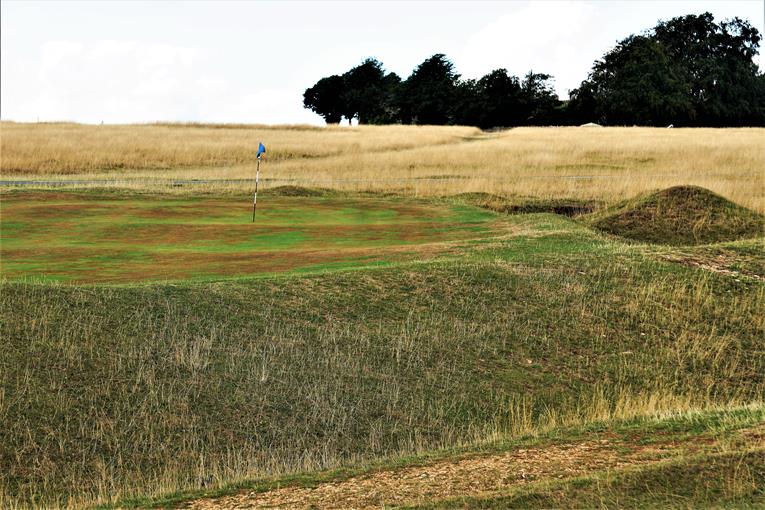
The devilish 16th green, where the effective area for a tee ball to finish on the same tier is teensy-weensy.
Seventeenth hole, Halfway House, 275 yards; The move this century of the tee from across the road (and thus the shortening of the hole) happens to dovetail perfectly with advancements in technology to create a superb risk/reward hole late in the round. As now played, the hole is drivable but downside abounds thanks to the tilt of the green from left to right. Any tee ball played too far left is in strife and at odds of getting up and in. Of course, the most obvious severe trouble is right but it is the cant of the green that really confounds.
Eighteenth hole, Clubhouse View, 405 yards; The only two markedly uphill walks come at two holes near the clubhouse (the third and here), which helps explain the wonderful views afforded from the clubhouse and lodge next door. Suffice to say, the various people who had their hand in the evolution of the course never believed and/or sought permission to provide visual aids to assist the golfer. Ultimately, golfers are asked to play the old fashioned way here, which is to say by feel. It’s a most welcome re-introduction to one of the glories of the sport that has been lost in time by over-zealous framing by modern architects and range finders. Minchinhampton stands for proper golf.
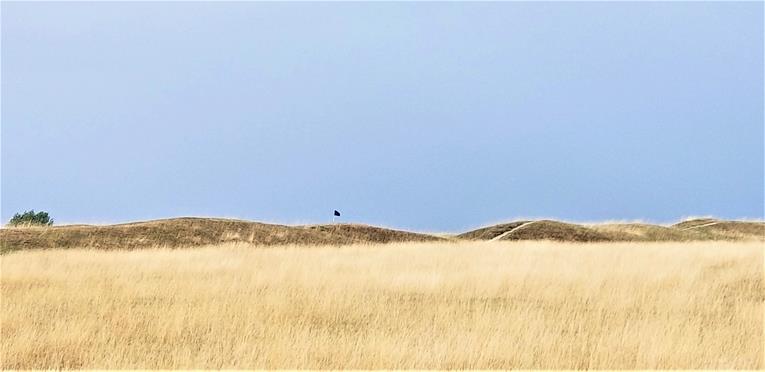
The Home green, as seen from near where the old seventeenth once was across the road. The mounds hold great appeal, largely due to their irregular nature. Modern architects make such mounds look far too symmetrical.

The clean lines and uncluttered simplicity of Minchinhampton makes the golfer question the merit of the architecture where he normally plays. Not only is Minchinhampton in all likelihood much more fun, it is also markedly less expensive to maintain in a suitable manner.
Course presentation follows the weather. Certainly, the above photographs from August reflect the dry, hot summer of 2018. The same photos taken after a wet fall would – of course – feature materially different hues – and the author loves that. Too many courses in North America fight nature rather than reflect it. Firm playing surfaces are key for Minchinhampton to sparkle, so what a delight to have seen it under these conditions. There is no Stimp reading referenced on a chalk board outside the professional shop; you get what you get with most days seeing the greens running perhaps on average around an 8. True, some people who believe that it is a birth right for a well struck putt to go in might find inconsistencies in the putting surfaces not to their liking but this golfer would never think to take the outcome of a putt so seriously. A sporty course with quirk and nuances trumps an artificial one everyday.
Two stories sum up the appeal of Minchinhampton Old. The first is from Mr. Nash who recounts the horrible day in the mid 1940s when the clubhouse burnt to the ground. An elderly member could see the fire from his sick bed at Stroud Hospital. Upon being told the club was on fire, he replied, ‘In that case, there is no point in living.’ He turned from the view and passed away.
On a more upbeat note, though no more heartfelt, the second story is highly personal. My wife has accompanied me many times to the United Kingdom. In general, she is quite happy to go for a jog while I play and sometimes she opts to accompany me. On the occasion when we found ourselves at Minchinhampton Old, something else happened – she decided to play. This had only happened at Cabot Links before but she was so moved by the ambiance and the setting that the common enjoys. She hadn’t swung a club for several years but after a few holes, she settled into a rhythm and started bashing it. She was literally overcome with enthusiasm for the sport. If you ever want a concise definition of a great course, that is it: it makes people fall in love with the sport. Minchinhampton Old performed that trick that very day; compare that to the thousands of more expensive places that are abject failures in luring people into the sport. In this age of consumerism, OLED screens, and things that beep at you, the value in spending time on the common at Minchinhampton is even more acutely felt – and appreciated.


